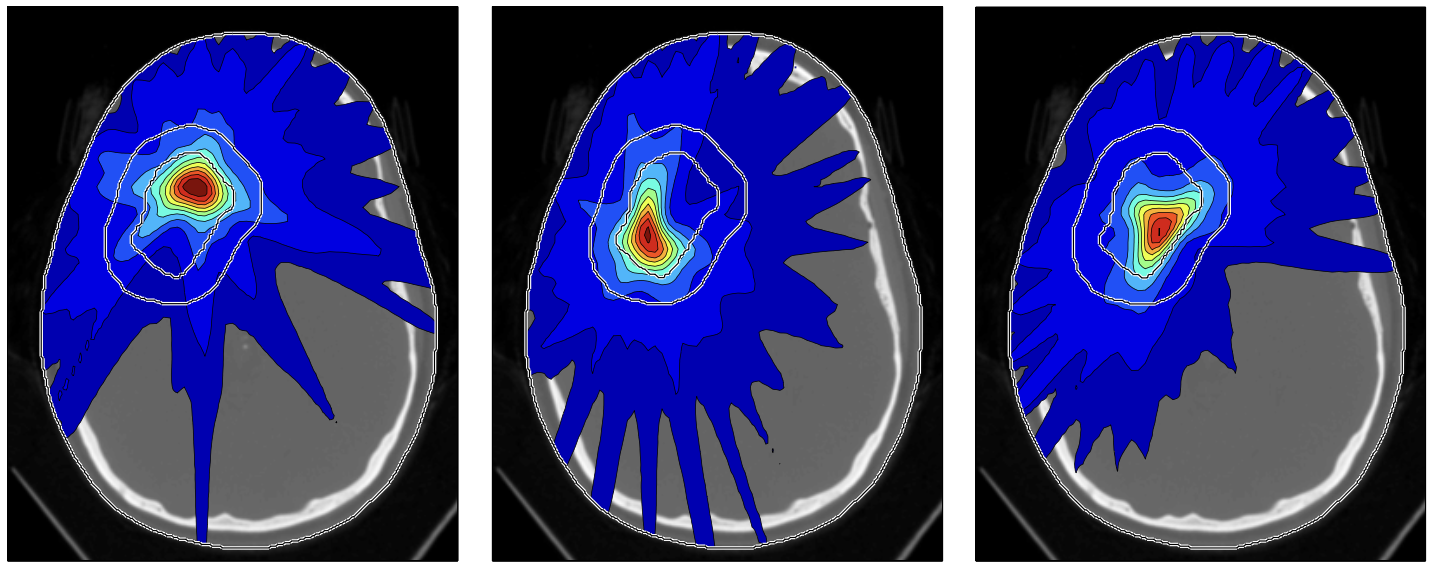Spatiotemporal fractionation
In current clinical practice, most radiotherapy treatments are fractionated. This is motivated by the observation that most healthy tissues can tolerate a much higher total dose if the radiation is split into small fractions. On the other hand, fractionation typically requires that a higher total dose is delivered to the tumor in order to achieve the same level of response. Fractionation decisions therefore face the tradeoff between increasing the number of fractions to protect normal tissues and increasing the total dose to maintain the same level of tumor control.
In that regard, the ideal treatment would fractionate in normal tissues, and at the same time hypofractionate in the tumor. This appears to be impossible at first glance because the dose to normal tissues is an unavoidable consequence of delivering dose to the tumor. Generally, increasing the dose to the tumor in a given fraction will increase the dose to healthy tissues in that fraction. However, interestingly it is possible to achieve some degree of hypofractionation in parts of the tumor while exploiting the fractionation effect in normal tissues. The latter can be achieved by delivering distinct dose distributions in different fractions, a concept which is referred to a spatiotemporal fractionation.
Figure 1 illustrates the concept of spatiotemporal fractionation for treating a large cerebral arteriovenous malformation (AVM). The treatment consists of 3 fractions delivered with rotation therapy (VMAT or Tomotherapy). Each fraction delivers a high single fraction dose to a distinct part of the target volume. At the same time, each fraction creates a similar dose bath in the surrounding normal brain and thereby exploits the fractionation effect. Hence, partial hypofractionation in the target volume is achieved with more uniform fractionation in normal tissues, which yields a net improvement of the therapeutic ratio. This demonstrates that there may be a benefit of delivering different dose distributions in different fractions, purely motivated by fractionation effects rather than geometric changes of the patient.
Figure 1: Spatiotemporal treatment plan for a large cerebral AVM.
Application to multiple brain metastases
Multiple brain metastases are another potential clinical application of spatiotemporal fractionation. The rationale is as follows: Small metastases may be treated to a high dose in a single fraction. Thereby, the physical dose needed to control the metastasis is reduced compared to fractionated rediosurgery. However, by treating different metastases in different fractions, some degree of fractionation is achieved in the normal brain between the metastases. Large metastases can be treated more uniformly fractionated. This is illustrated in figure 2.
Figure 2: Spatiotemporal fractionation for a patient with 30 brain metastases treated in 3 fractions.
Preclinical investigation of spatiotemporal fractionation
Spatiotemporal fractionation challenges a decade-old established paradigm of radiotherapy, namely that the total radiation dose is evenly split into many fractions and the same dose distribution is delivered every day. Therefore, preclinical studies in experimental animal models may be warranted to validate key assumptions behind the concept of spatiotemporal fractionation. In collaboration with the radiobiology lab of Martin Pruschy, we currently study the effect of partial tumor irradiation in each fraction using a high precision small animal irradiator. Initial work can be found in our recent publication.
- I. Telarovic, J. Krayenbuehl, I. Grgic, F. Tschanz, M. Guckenberger, M. Pruschy, J. Unkelbach. Probing spatiotemporal fractionation on the preclinical level. Phys. Med. Biol. 65(22):22NT02, 2020
Selected prior publications
- N. Torelli, D. Papp, J. Unkelbach. Spatiotemporal fractionation schemes for stereotactic radiosurgery of multiple brain metastases. Medical physics, 50(8):5095-5114, 2023
- J. Unkelbach, M. Bussière, P. Chapman, J. Loeffler, H. Shih. Spatiotemporal Fractionation Schemes for Irradiating Large Cerebral Arteriovenous Malformations. Int. J. Rad. Onc. Biol. Phys., 2016;95(3):1067-1074
- Unkelbach J, Papp D, Gaddy MR, Andratschke N, Hong T, Guckenberger M. Spatiotemporal fractionation schemes for liver stereotactic body radiotherapy. Radiother Oncol. 2017 Nov;125(2):357-364
- Gaddy MR, Unkelbach J, Papp D. Robust spatiotemporal fractionation schemes in the presence of patient setup uncertainty. Medical physics 46 (7), 2988-3000, 2019
- Gaddy MR, Yıldız S, Unkelbach J, Papp D. Optimization of spatiotemporally fractionated radiotherapy treatments with bounds on the achievable benefit. Phys. Med. Biol. 2018;63(1):015036
- J. Unkelbach, D. Papp. The emergence of nonuniform spatiotemporal fractionation schemes within the standard BED model. Med. Phys., 2015;42:2234-2241

